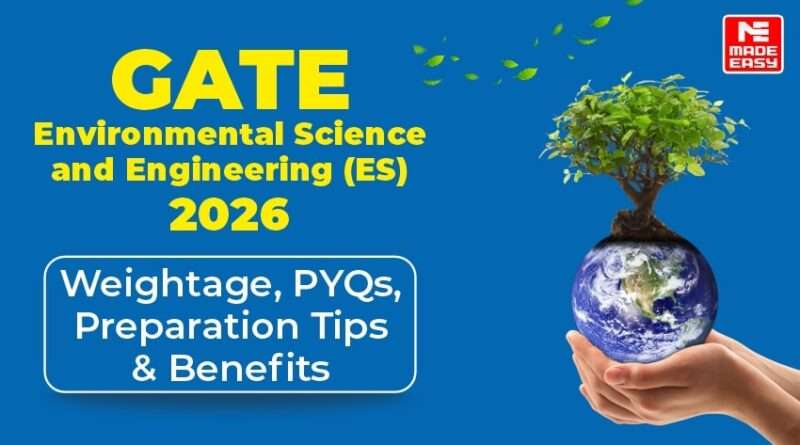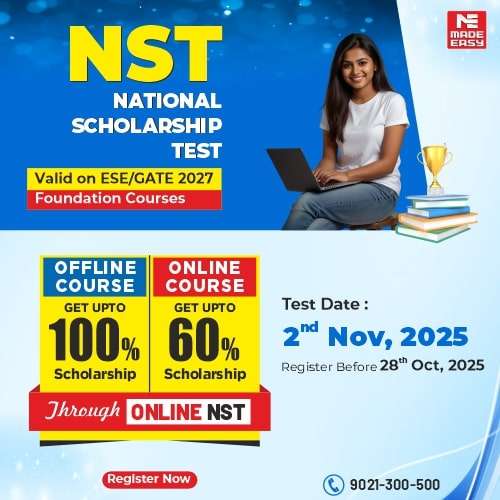GATE ES 2026 Weightage, PYQs, Preparation Tips & Benefits
The Graduate Aptitude Test in Engineering, popularly known as GATE is one of the most important exam for engineering graduates and students who aspire to pursue higher studies like M.S., M.Tech, PhD from various national and international universities like NUS, NTU, Berlin University etc. GATE is conducted annually jointly by 7 IITs and IISc Bengaluru. In 2026, GATE will be conducted by IIT Guwahati. As per the official website of GATE 2026, there would be 30 streams in which GATE 2026 would be conducted. Environmental Science and Engineering (paper code: ES) is an interdisciplinary stream where candidates from civil engineering as well as candidates from environmental engineering can appear. In this blog, we would discuss about GATE ES (Environmental Science and Engineering) Subject Wise Weightage, exam pattern, syllabus etc. Those candidates who are interested in appearing in GATE ES 2026 would find this blog useful. The tips and benefits of GATE ES 2026 would motivate the aspirants to appear in GATE for environmental science and engineering in 2026.
What is GATE ES?
ES is the code for environmental science and engineering in the GATE test paper. As said above, it is an interdisciplinary field, and therefore it is preferred by students of different streams, like environmental engineering, civil engineering, etc., for admissions in various postgraduate engineering courses in different technical institutes of the country.
Generally, PSUs don’t recruit through GATE ES; however, a GATE ES score is useful for admission to postgraduate courses in different technical institutes ’like IITs, IISc Bengaluru NITs, and others.
GATE ES (Environmental Science and Engineering) Subject Wise Weightage, syllabus, mark distribution and exam pattern
GATE ES 2026 marks distribution
Marks distribution of environmental science and engineering in GATE 2026 is given below.
General aptitude: 15 marks
Engineering Mathematics: 13 marks
Subject questions: 72 marks
Total marks: 100
The exam pattern of GATE ES 2026 is the same as any other stream. Let us have a look at the exam pattern of GATE ES 2026.
| Particular | Details |
|---|---|
| Mode of examination | CBT based English medium |
| Duration | 3 hours |
| Type of questions | MCQ MSQ NAT |
| Question for testing these abilities | Recall Comprehension Application Analysis and synthesis |
| Marking scheme | Questions carry 1 marks and 2 marks |
| Negative marking | For a wrong answer chosen in an MCQ, there will be negative marking. For a 1-mark MCQ, 1/3 mark will be deducted for a wrong answer. For a 2-mark MCQ, 2/3 mark will be deducted for a wrong answer. There is no negative marking for wrong answer(s) to MSQ or NAT questions. There is no partial marking in MSQ |
GATE ES 2026 Syllabus
Section 1: Mathematics Foundation
Linear Algebra: Determinants and matrices, Systems of linear equations, Eigen values and eigenvectors.
Calculus: Functions, Limit, Continuity, Differentiability, Local maxima and minima, Taylor series, Tests for convergence, Definite and indefinite integrals, Application of definite integral to obtain area and volume, Partial and total derivatives.
Differential Equations: Linear and non-linear first order ordinary differential equations (ODE), Higher order linear ODEs with constant coefficients, Cauchy’s and Euler’s equations, Laplace transform and its application in solving linear ODEs.
Probability and Statistics: Descriptive statistics, Measurement of central tendency, Dispersion, Skewness and kurtosis, Probability concepts, Conditional probability, Bayes theorem, Risk and reliability, Probability distributions, Correlation, Single and multiple regression models, Hypothesis testing (t-test, F-test, chi-square test).
Section 2: Environmental Chemistry
Fundamentals of Environmental Chemistry: Covalent and ionic bonding; Chemical equations, concentration and activity; Structure and chemistry of organic molecules; Radioactivity of elements; Chemical equilibria; Thermodynamics and kinetics of chemical reactions.
Principles of Water Chemistry: Water quality parameters and their measurement; Acid-base equilibria; Buffer solution; Carbonate system; Solubility of gases in water; Complexation, precipitation, and redox reactions; Inorganic and organic contaminants in water and their speciation.
Soil Chemistry: Organic matter, nitrogen, phosphorous, potassium, cation exchange capacity, base saturation, and sodium absorption ratio.
Atmospheric Chemistry: Composition of the atmosphere; Reactivity of trace substances in the atmosphere; Urban atmosphere—smog and particulate pollution; Chemistry of ozone formation; Chemistry of stratosphere
Section 3: Environmental Microbiology
Prokaryotic and Eukaryotic Microorganisms: Characteristics of diverse groups of microorganisms; Classification of microorganisms; Microbial diversity; Plant-microbe and soil-microbe interactions; Role of microorganisms in wastewater treatment, bioremediation and biogeochemical cycling.
Cell Chemistry and Cell Biology: Structure of proteins, nucleic acid (DNA & RNA), lipids and polysaccharides; Bonds in biomolecules; Stereoisomerism in biomolecules; Structure of cell; Structure and function of cytoplasmic membrane, cell wall, outer membrane, glycocalyx, chromosomes, endospores, storage products, mitochondria and chloroplasts.
Microbial Metabolism: Anabolism and catabolism; Phosphorylation; Glycolysis; TCA cycle; Electron transport chain; Fermentation; Anaerobic respiration; Energy balances; Enzymes and Enzyme kinetics.
Growth and Control of Microorganisms: Bacterial nutrition and growth; Specific growth rate and doubling time; Monod’s model; Types of culture media; Batch and continuous culture; Effects of environmental factors on growth; Control of microbes using physical and chemical methods.
Microbiology and Health: Pathogens and modes of transmission; Indicator organisms; Quantification of coliforms using MPN and membrane filtration techniques.
Section 4: Water Resources and Environmental Hydraulics
Global Water Resources: Structure, properties and distribution of water; Water quality; Threats to water resources; Water conservation.
Surface Water Resources: Hydrological cycle and water balance – precipitation, infiltration, evapotranspiration, runoff; Flow hydrographs; Unit hydrographs; Stage-discharge relationship; Reservoir capacity; Reservoir and channel routing; Surface run-off models; Surface water management; Rain water harvesting and storage.
Groundwater Resources: Geologic formations as aquifers; Vadose and saturated zones; Confined and unconfined aquifers and their parameters – porosity, permeability, transmissivity and storage coefficient; Darcy’s law and applications; Steady state well hydraulics.
Environmental Hydraulics: Concepts of mechanics; Properties of fluids; Pressure measurement; Hydrostatic force on surfaces; Buoyancy and flotation; Laminar and turbulent flow; Flow through pipes; Pipe networks; Boundary layer theory; Forces on immersed bodies; Flow measurement in channels and pipes; Kinematics of flow; Continuity, momentum and energy equations; Channel hydraulics – specific energy, critical flow, hydraulic jump, rapid and gradually varied flow; Design of lined and unlined channels.
Section 5: Water & Wastewater Treatment and Management
Water and wastewater quality parameters; Eutrophication and thermal stratification in lakes; River pollution – Oxygen sag curve.
Water treatment methods – screening, sedimentation with and without coagulation, filtration, desalination, disinfection; Water distribution and storage
Point and non-point sources of wastewater; Population forecasting methods; Design of sewer and storm water sewers; Sewer appurtenances; Preliminary, primary, secondary and tertiary sewage treatment; Sludge generation, processing and disposal methods; Sewage farming.
Sources and characteristics of industrial effluents; Concept of Common Effluent Treatment Plants (CETP); Wastewater recycling and zero liquid discharge.
Kinetics and reactor design: Mass and energy balance, Order and rate of reactions, Batch reactors, Completely mixed flow reactors, Plug flow reactors.
Section 6: Air and Noise Pollution
Structure of the atmosphere; Natural and anthropogenic sources of pollution; Atmospheric sources, sinks, transport; Indoor air pollution; Effects on health and environment; Air pollution: gases and particulate matter; Air quality standards; Primary and secondary pollutants; Criteria pollutants, ambient and source standards, air quality indices, visibility.
Particulate Pollutants: Measurement and control methods; Control of particulate air pollutants using gravitational settling chambers, cyclone separators, wet collectors, fabric filters (Bag-house filter), electrostatic precipitators (ESP).
Gaseous Pollutants: Measurement and control methods; Control of gaseous contaminants: absorption, adsorption, condensation and combustion; Control of sulphur oxides, nitrogen oxides, carbon monoxide, and hydrocarbons; Vapour-liquid and vapour-solid equilibria; Diffusion, Fick’s law and interfacial mass transfer. Automotive emission controls, fuel quality, diesel particulate filters, catalytic convertors.
Air Quality Management: Point, line and area sources; Inventory; Influence of meteorology – wind rose diagrams, stability, mixing height, topography, dispersion modelling, monitoring.
Noise Pollution: Sources; Health effects; Standards; Measurement and control methods.
Section 7: Solid and Hazardous Waste Management
Integrated solid waste management; Waste hierarchy; Rules and regulations for solid waste management in India.
Municipal solid waste management: Sources, generation, characteristics, collection and transportation, waste processing and disposal (including reuse options, biological methods, energy recovery processes and landfilling).
Hazardous waste management: Characteristics, generation, fate of materials in the environment, treatment and disposal. Soil contamination and leaching of contaminants into groundwater.
Management of biomedical waste, plastic waste and E-waste: Sources, generation and characteristics; Waste management practices including storage, collection and transfer.
Section 8: Global and Regional Environmental Issues
Global effects of air pollution: Greenhouse gases, global warming, climate change, urban heat islands, acid rain, ozone hole.
Ecology and various ecosystems; Biodiversity; Factors influencing increase in population, energy consumption, and environmental degradation.
Section 9: Environmental Management and Sustainable Development
Environmental Management Systems; ISO14000 series; Environmental Auditing: Environmental Impact Assessment; Life cycle assessment; Human health risk assessment.
Environmental Law and Policy: Objectives; Polluter pays principle, Precautionary principle; The Water and Air Acts with amendments; The Environment (Protection) Act (EPA) 1986; National Green Tribunal Act, 2010; National Environment Policy; Principles of International Law and International treaties.
Energy and Environment: Energy Sources: Overview of resources and reserves; Renewable and non-renewable energy sources; Energy-Environment nexus.
Sustainable Development: Definition and concepts of sustainable development; Sustainable development goals; Hurdles to sustainability; Environment and economics.
GATE ES (Environmental Science and Engineering) Subject Wise Weightage
Subject wise weightage is very important for GATE aspirants. It helps them to strategize their preparation in a way so that they can obtain maximum output from it. In this section, we are providing subject wise weightage for GATE ES. This subject wise weightage analysis would help the aspirants to prioritize the high weightage subjects first.
Let us look at the subject wise analysis for GATE ES:
| Subject | Approximate Weightage (marks) |
|---|---|
| General Aptitude | 13-15 |
| Mathematics Foundation | 13-15 |
| Mathematics Foundation (within core ES) | 10 |
| Environmental Chemistry | 4 |
| Environmental Microbiology | 5 |
| Water Resources and Environmental Hydraulics | 4 |
| Water & Wastewater Treatment and Management | 8 |
| Air and Noise Pollution | 6 |
Solid and Hazardous Waste Management | 9 |
| Environmental Management and Sustainable Development | 6 |
Global and Regional Environmental Issues | 3 |
GATE ES aspirants should note that these are approximate weightage of subjects based upon the analysis of previous year papers. In GATE 2026, the weightage of subjects may increase or decrease.
GATE ES Preparation Tip
Generally, students of civil engineering, chemical engineering, and environmental engineering appear in GATE environmental science and engineering. Therefore, to prepare for GATE ES, students should focus on their technical subjects along with mathematics and general aptitude. After selecting the subjects, candidates should study and revise all the concepts and attempt multiple tests to check their strengths and weaknesses. Aspirants should also focus on mathematics and general aptitude along with technical subjects. Candidates should strategize their preparation according to GATE ES (Environmental Science and Engineering) Subject Wise Weightage
A good GATE score in ES helps aspirants in getting shortlisted for various M.Tech courses in top technical institutes like IITs, IISc, NITs, etc.
Environmental Science and Engineering is not a difficult stream in GATE if aspirants prepare well. Generally, civil and chemical engineering candidates choose engineering science as the second paper for GATE so that in case they can’t get shortlisted in PSU or for an M.Tech interview in their desired institution through the mechanical engineering branch, they can get shortlisted for an M.Tech interview on the basis of the GATE ES score.
FAQs:
1. What are the subjects weightage in GATE ES (Environmental Science and Engineering)?
Answer: The subject wise weightage in GATE ES is given below:
| Subject | Approximate Weightage (marks) |
|---|---|
| General Aptitude | 13-15 |
| Mathematics Foundation | 13-15 |
| Mathematics Foundation (within core ES) | 10 |
| Environmental Chemistry | 4 |
| Environmental Microbiology | 5 |
| Water Resources and Environmental Hydraulics | 4 |
| Water & Wastewater Treatment and Management | 8 |
| Air and Noise Pollution | 6 |
Solid and Hazardous Waste Management | 9 |
| Environmental Management and Sustainable Development | 6 |
| Global and Regional Environmental Issues | 3 |
2. What is a good score in GATE ES?
Answer: A good score in GATE ES varies as per the desire of GATE aspirants. Those who want to pursue higher education from top colleges like IIT, IISc, etc., should have to score more marks.
3. Are the questions repeated in the GATE ES exam?
Answer: Generally, questions are not repeated in GATE exam, however the concepts get repeated.
4. Who is eligible for GATE environmental science and engineering?
Answer: The eligibility criteria for GATE ES is same as any other GATE paper that is candidates currently studying in 3rd year or higher of any UG degree program are eligible to appear in GATE 2026. For more detail on eligibility criteria, candidates can visit here.
5. What are the benefits of GATE ES?
Answer: A good GATE score in ES helps aspirants in getting shortlisted for various M.Tech courses in top technical institutes like IITs, IISc, NITs, etc.
We wish all the very best to every GATE 2026 ES aspirant.
Dear Aspirants,
Your preparation for GATE, ESE, PSUs, and AE/JE is now smarter than ever — thanks to the MADE EASY YouTube channel.
This is not just a channel, but a complete strategy for success, where you get toppers strategies, PYQ–GTQ discussions, current affairs updates, and important job-related information, all delivered by the country’s best teachers and industry experts.
If you also want to stay one step ahead in the race to success, subscribe to MADE EASY on YouTube and stay connected with us on social media.
MADE EASY — where preparation happens with confidence.

MADE EASY is a well-organized institute, complete in all aspects, and provides quality guidance for both written and personality tests. MADE EASY has produced top-ranked students in ESE, GATE, and various public sector exams. The publishing team regularly writes exam-related blogs based on conversations with the faculty, helping students prepare effectively for their exams.





